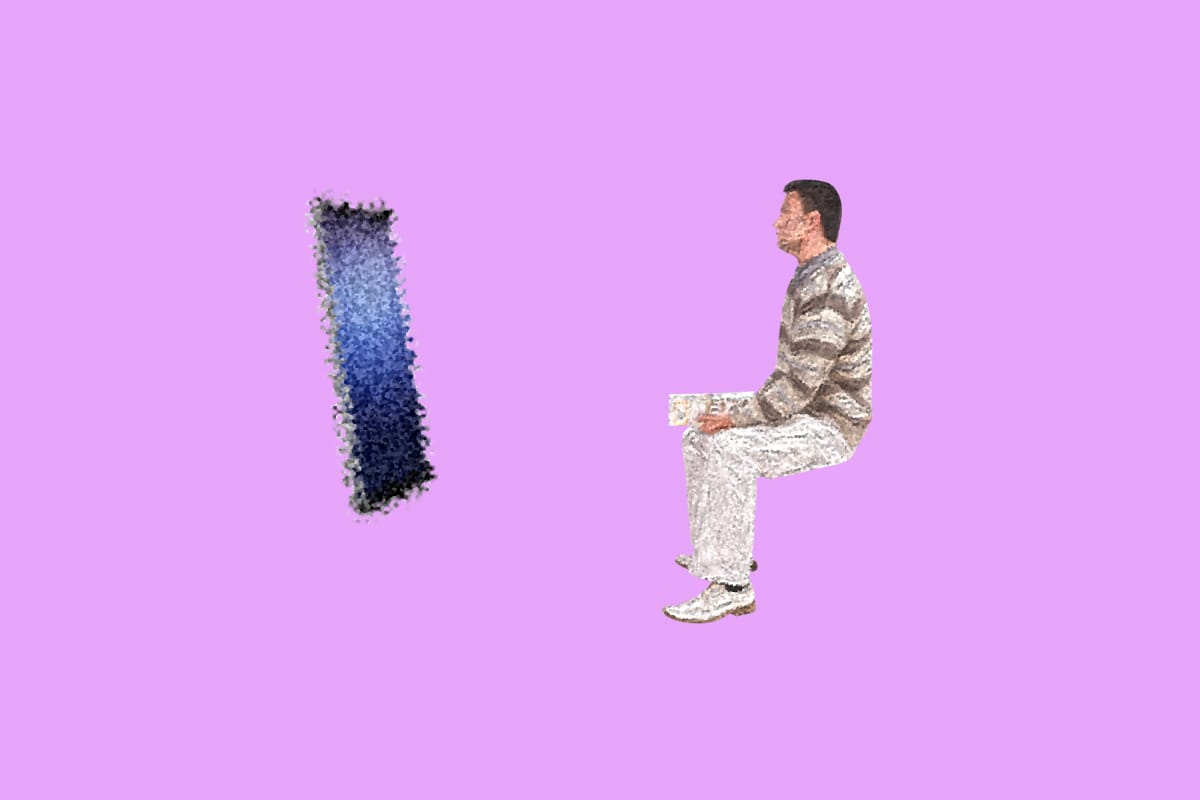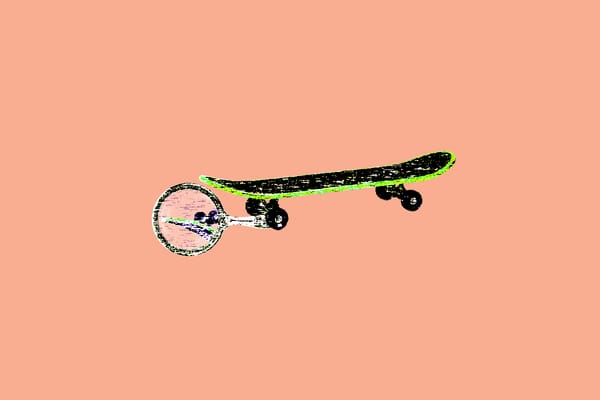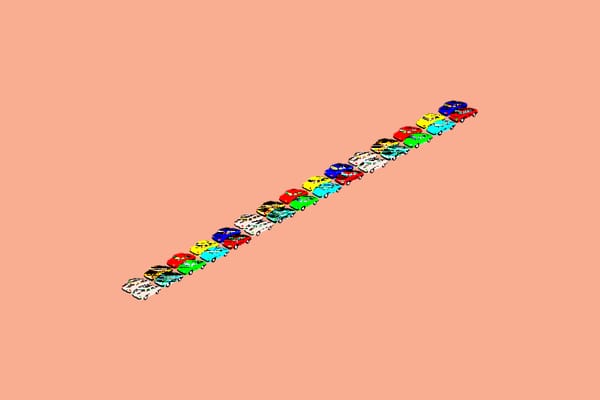Looking through the glass
Contending with content, a media in decline, and skateboarding’s future online.


The distance seemed different. The horizon I stare into every day had lost its edge; its details softened like a watercolour painting. I cleaned my glasses, squinted, and sighed.

🤳 The present comes into focus 🤳
It’s akin to a loss of object permanence. Nearly every day, I open a browser window or the Instagram app and witness one of the most breathtaking feats of skateboarding ever accomplished and captured on video. Then I forget it. Sometimes, it’s gone as soon as the window or app is closed. Occasionally, it’ll live on briefly in the group chat where my friends and I marvel or talk shit before someone shares a photo where it looks like a dog is operating a forklift and our collective memory collapses.
This cycle is, with no exaggeration, a travesty — one that I willingly participate in. Day after day, skateboarding progresses online. The tricks we see in the small, smudged-up screens of our smartphones compound in creativity and difficulty as brands release new videos on a suffocating schedule. The cracks between those efforts jammed with professional, amateur, and everyday skateboarders flooding social media with poorly captured footage of never-before-been-done maneuvers filmed on the device they use to upload it. With all these riches, one should be grateful, but there is no time to revel. Instead, we do what the platforms demand of all of us and post with no endgame in sight.
It’s here, and through this endless exchange, that the act of skateboarding changes. It becomes routine, an input. Feed. The years that older generations used to wait between video releases, the multiple magazine features hyping a project, the strained magnetic tape in an overused VHS cassette, scratched DVDs — all artifacts, memories of a time when a skateboarding video wasn’t an upload. When a brand’s marketing budget wasn’t just fat but existed. A bygone era that has been usurped by the same thing the rest of culture has: a constant, unrelenting demand for content.
Of course, this is exactly what a millennial skateboarder weaned on a dying media ecosystem would say. TransWorld Skateboarding Magazine was almost phonebook-thick when I got into skateboarding in 1998. Before that, and in the years that followed, multiple major American skateboarding magazines, like TransWorld, Thrasher, SLAP, Big Brother, Skateboarder, and The Skateboard Mag, dominated and dictated the culture globally.
To thumb through a heavy, glossy skate mag in that era was to enter another world. Sure, most existed as a means to advertise products (Eric Swenson and Fausto Vitello notably started Thrasher in 1981 as a vehicle to promote their company Independent Trucks), but they provided so much more.
Every month, you’d get an annotated guide to skateboarding’s technical evolution and discover new skaters, brands, trends in tricks and aesthetics — things to care about and stew over until the next issue arrived. I remember the promotional push for Girl Skateboards’ seminal video Yeah Right! lasting years. It was marketing as mythmaking with the time and resources to spare. That's unfathomable now.
For a skater to get a photo in a magazine meant something more; it was proof of skill, style, and life. To be the subject of a “Checkout” style feature — designed to highlight up-and-comers — declared you as one to watch. To grace the cover cemented your legacy. I covered the wall of my childhood bedroom with the pages of TransWorld, staring and daydreaming and indoctrinating myself in the culture I believed skateboarding to be and the one I wanted to be a part of.
All that remains of the major American magazines is Thrasher, which a 2021 San Francisco Chronicle article noted had a circulation of over 100,000 at the time. In recent years, its primary offerings with the greatest reach and assumed financial impact have been its online content and branded merch. The company produces high-quality original videos and charges brands to publish theirs through official Thrasher channels. Thrasher merch is sold everywhere from Zumiez and Amazon to bland digital fashion outlets. Those separate business arms exist to help the magazine whose name they share survive.
Traditional print media in skateboarding was a once powerful and ever-present force, even outside the American bubble. In Canada, there were at one time four prominent magazines for a population a tenth the size of the United States: Concrete, Color, SBC Magazine, and King Skate (previously known as King Shit). Only SBC and King Skate remain, each with skeleton crews and publishing schedules that could best be described as “whenever we have the money” (I say this lovingly and forlornly, as someone who has contributed to both for over a decade).
Britain’s longest-running print effort, Sidewalk, ran from 1995 to 2015. The pan-European magazine Kingpin would fold the same year. Free Skate Mag would fill the void as the last major print publication in Europe, with a quarterly-ish release schedule and a focus on online content.
A raft of smaller magazines continue to exist, most relatively new, like Closer, Mess, Vague, Dolores, Grey, 2001, and more. These are not money-making endeavours; instead they are born of a dedication to the medium and care for the scenes they cover. A July 2023 article for Quartersnacks by Mike Munzenrider describes the efforts of this cohort as “radical acts of love.”
“It’s a community-based project and I’m putting everything I can into making something of quality that skaters will appreciate,” [Jaime Owens of Closer] says. “When I say project, I’m not discounting it as a business, but it’s like an art project. I’m trying to put in as much passion and love of skateboarding culture [as I can], make it more than a business.” Shari White has similar feelings about Mess, which releases a new issue when the new issue is done: “This is a passion project, not a business.”
The business side of things is where things have gone awry for media at large, whether digital or print. Owens, the former editor of Skateboarder, which shut down in 2013, told Munzenrider, “Even in the early Skateboarder days — the mid-2000s — there were signs that magazines could be in trouble in the coming years. You had to switch gears and do everything you could to keep it going.” That trouble came swift and fierce. TransWorld published a list of ten “dead print mags” in its July 2015 issue that included Skateboarder, SLAP, Big Brother, Sidewalk, Kingpin, and Color. It would join that list in March 2019.
In the years since, TransWorld has lived on in a zombie-like state, its website churning out SEO-optimized aggregate slop that gets run through various newsreader services. The Arena Group, the media conglomerate behind the embarrassing mismanagement of Sports Illustrated (which it licensed from another conglomerate in Authentic Brands Group to publish under the SI name), acquired Men’s Journal, the parent company of TransWorld, and has since farmed it out for clicks and whatever Google Ad revenue it can scrounge up.
This mess is not so much the exception as it is the rule in the contemporary media landscape. Outlets like SI, Vice, Mic, Deadspin, Pitchfork, Gawker 2.0, The Outline, and even Popular Science have all suffered a similar fate: Executive incompetence in the face of a changing ad market leads to either a shuttering or a sale to an unfeeling private equity or management firm that doesn’t understand its new audience, culls staff, and attempts to monetize everything it can, in turn alienating its readership and rendering it effectively dead.
All of this was sped up by the internet and social media’s dominance in how we’ve come to consume information and culture, or how we refer to it now, content. Of course, technology advances and businesses must adapt, but it’s more than that. We have long known that Facebook fabricated data to convince news and media companies to “pivot to video,” leading to mass layoffs and a shift of focus away from written work. Tweaks to Google’s search algorithm regularly break independent ventures. All of this has happened while social media companies leached advertiser dollars away from print and digital media publishers, positioning their platforms as a more valuable marketing vector than those creating the “content” and subsequent discourse that fills their users' feeds.
Skateboarding was not exempt. As the old guard of media died off, Instagram arguably became the locus of the skateboarding universe, competing only with Thrasher's website. PROs, AMs, up-and-comers, newbies, brands — everyone began to post. In just a few years, it became the norm. Expected. A provision included in the shoe contract.
The ability to build a personal brand through these platforms altered the nature of professional skateboarding and what “sponsorship” looks like. A robust following and output on social media are now as important or more than a skater’s section in a video or coverage in what magazines are left. The skateboarding a professional skateboarder does is still essential, but for many, leveraging being a professional skateboarder on these platforms has become an alternative or superior revenue stream in a notoriously low-paying career path. Aaron “Jaws” Homoki used his notoriety as a PRO to promote a Twitch account where you could purchase a paid subscription to watch him play Tetris. Nora Vasconcellos splices skateboard tricks with self-filmed testimonials for organic protein powders in SponCon Instagram posts. Paul Rodriguez, the young star of Yeah Right! and one of the industry’s biggest successes, has become a dedicated YouTuber who does unboxing videos for his nearly 320k subscribers.
Whether this is a travesty depends on who you ask. What is certain is that it requires more — more of the athletes who create and more of the audiences who watch because ephemerality is our nature now. We tell a Story to forget it in a day.
Without much thought or fight we accepted this as our future, now our present. One that’s guided by tech companies who make billions collecting our data and manipulating our viewing habits in order to optimize their ability to sell us garbage. They’ve been successful. If we want to see what we love, we now look to our phones, where an algorithm will always oblige.

I rest my chin in the holster and peer into the machine. A cross made of green dots pulls in and out of focus against a buzzing red background like pixellated hellfire. The cross moves around the screen and I am tasked with staring into it, first with my left eye and then my right. Do not blink, the optometrist says. There’s a flash. There are many flashes. During a previous appointment, the optometrist noticed my right cornea was larger than the left. Not unusual, but she wanted to take a closer look.
This is that closer look, candid snapshots of my optic nerve. I’m told my eye pressure, which I wasn’t aware was a thing, is healthy. I’m shown a green circle divided into quarters like pieces of key lime pie. Green is good. That is my left eye. I’m shown another pie, my right eye. All of its slices are green — except for the bottommost, which is yellow. That is not great. Perhaps nothing, but not nothing, as I’m referred to a specialist. There’s a history of glaucoma and macular degeneration in my family. I also stare at a computer for work and pleasure. Untold hours spent peering into that eternal blue light. All reasons to worry, but not yet. It’s routine until it isn’t.
I leave the office and immediately pull out my phone. Email notifications. An emoji reaction to a text message. By habit, I open Instagram. I see one of the most breathtaking feats of skateboarding ever accomplished and captured on video — is my yellow quadrant throbbing? It can’t be, but it might be. I put my phone away. I forget the trick.

🔎 In search of the intimate 🔎
In Kyle Chayka’s book Filterworld: How Algorithm’s Flattened Culture, the New Yorker writer argues that the proliferation of and our subsequent dependence on algorithms — those inscrutable calculations that determine everything from what we see in our social media feeds to the music, movies, and television shows that streaming services serve us — have worked to rid us of creative energy, drive, and even the development of personal taste. He contends the ease of relying on a machine instead of seeking out the human curation or tastemaking of a disc jockey, record and video store clerk, or the older kids at the skatepark cosplaying as the Menace Skateboards team, has both homogenized our interests and sterilized them.
Is this the effect that Paul Rodriguez, who appeared to be a few drinks deep, was trying to express when he appeared on an impromptu livestream with fellow YouTuber Bryan Arnett? “What I trip on is the human being[‘s] ability to adapt… like you guys can take in content because you’re trained [to]... we had time to absorb it. We didn’t know when the next big video was coming out and [had time] to learn all the shit in the video. But you guys, today the video comes out and tomorrow the new video comes out — how the fuck do you guys keep up with that shit and keep learning new tricks that fast?”
It’s a relatable observation for anyone in their 30s whose legs hurt from just walking up stairs, never mind jumping down them. To his credit, the 39-year-old Rodriguez makes sure to clarify that he knows it’s “not his time anymore,” but things still feel off.
“Maybe this is just an old man talking, but I think the soul of skateboarding is becoming watered down… I see certain people skating and they don’t have any soul. You have to learn the hardest trick — flip in, flip out, flip in, flip out. But you’re not learning why you have to learn that. Where’s the origin of this shit. They’re teaching you to become a robot…”
“[Skateboarding is] like music… There’s a soul to it. There’s a feeling to it. It’s not about who can play the best lick on the guitar. For some kids, it’s not even about style. It’s flip in, triple flip, quadruple flip out — it looks like my fucking asshole.”
Has the relentless churn of content disconnected us from our ability to sit with something and genuinely connect with it? Do they — the apps, the algorithms, and their content deluges — take something from us as they continue to give and give and we consume and consume? Gluttony is a sin, so perhaps that’s why Rodriguez thinks modern skateboarders lack “soul.” In less pointed terms, this instance seems like a matter of taste.
In Filterworld, Chayka defines taste as “the discernment that we all apply to figure out what we like… We make constant decisions to listen to, read, or wear one thing instead of another. These choices are intimate, reflecting our ephemeral moods and the slow building of our individual sensibilities — of our senses of self.”
Chayka quotes the French philosopher Montesquieu, who describes taste as “nothing else but an ability of discovering, with delicacy and quickness, the degree of pleasure which every thing ought to give to man.” Italian philosopher Giorgio Agamben, Chayka later notes, opined that “Taste enjoys beauty, without being able to explain it.” Those sentiments align with my own understanding and just, well, feel right, which is perhaps an example of my personal taste. That mercurial thing we all have and develop and pay attention to in infinite ways and amounts. What happens when such an intimate thing is given over to the whim of a machine and the calculations that run through it like plasma?
“If taste indeed must be deeply felt, requires time to engage with, and benefits from the surprise that comes from the unfamiliar, then it seems that technology could not possibly replicate it, because algorithmic feeds run counter to these fundamental qualities. When recommendation algorithms are based only on data about what you and other platform users already like, then these algorithms are less capable of providing the kind of surprise that might not be immediately pleasurable, that Montesquieu described.
“Building your own sense of taste, that set of subconscious principles by which you identify what you like, is an uphill battle compared to passively consuming whatever content feeds deliver to you. But the situation can’t solely be blamed on the presence of algorithms. Today we have more cultural options available to us than ever and they are accessible on demand. We are free to choose anything. Yet the choice we often make is to not have a choice, to have our purview shaped by automated feeds, which may be based on the aggregate actions of humans but are not human in themselves.”
Is what Chayka describes the root cause of Rodriguez seeing so many tricks that remind him of his presumably unkempt backside? It could be. It could also be that he’s simply aged out of the popular conversation. However, the reason he struggled to articulate his revulsion, besides the alcohol, likely has something to do with Montesquieu’s thoughts on the animating force of taste itself.
“Natural taste is not a theoretical knowledge, it’s a quick and exquisite application of rules which we do not even know.”

The specialist the optometrist referred me to called to schedule an appointment. Sitting at my computer in a loud cafe, I struggled to hear the person who would help determine whether or not I’d, at some point, struggle to see. At that moment, my understanding of how I understood the world felt up in the air, subject to permanent and irrevocable change.
This uncertainty is nothing new. As long as there have been people, people have been losing their senses, losing touch. Sometimes that’s because we’ve simply grown older. Other times, something has gone wrong.

🫲 Everything and nothing in the palm of your hand 🫱
Having the ability to look into these portals that sit on our desks and in our pockets and watch an infinite sea of content geared toward our presumptive or soon-to-be prescribed interests as defined by those portals hasn’t turned out great so far. There was promise at one point, and perhaps there still might be, but corporate and political avarice generally win out in our present world. As such, social media platforms and the algorithms they employ to suck us into their depths have worked to turn us into eternal consumers while disassembling our foundations of media, tastemaking, and even shared reality. It didn’t take that long. It was all upended in about 15-20 years by a gaggle of greedy, visionless dorks.
It would be short-sighted to say this change in our means of consumption has been all negative, though. Despite its opaque, homogenizing algorithms, social media has still introduced whole generations of people to new art, artists, and pastimes they likely wouldn’t have found or had the motivation to get into otherwise. It’s oft and correctly noted that social media has democratized an otherwise imbalanced media environment, allowing the regular Joe to get noticed, tweet truth to power, and organize significant social movements. In skateboarding, the inherent gatekeeping of the traditional media ecosystem, which would (and to a considerable extent still does) decide what skateboarders and brands gain a foothold in the industry, can now be bypassed to a certain extent.
Countless crews have gained recognition online by their own means and social channels before a Thrasher catches up. A distinct lack of mainstream coverage of women and LGBTQ2S skaters was suddenly able to be subverted by the providence of an Instagram page. Organizations and events catering to those groups popped up all over the world in the late 2010s before exploding in popularity in the early days of the pandemic, where any sort of distanced, outdoor communal activity like skateboarding was at a premium.
From Hera in Germany, froSkate in Chicago, to Takeover in Vancouver, the alternative platforms of social media were their means for reaching the public. Unity, likely the most well-known LGBTQ2S skate collective, began with artist and skater Jeff Cheung putting out a call on Instagram to queer and trans skaters wanting to meet up and skate in a safe, welcoming environment. They’ve since taken their meet-ups global and their board brand, There, is distributed by Deluxe, the home of Real, Krooked, and Antihero Skateboards, three of the strongest legacy brands in the industry.
If we frame that genuinely positive progress in the most cynical sense, social media and its gamification features of likes, shares, and follower counts have provided brands and media outlets with metrics that proved these criminally underrepresented skaters had audiences worth marketing to, and thus, were deserving of endorsements and features in magazines and videos. But what those metrics also represent are movements, and a win is a win.
Virality. Reach. The value ascribed to our work and ourselves can and will be measured by how many people interact with our content. It’s not like this has never existed in some form. Box office, Nielsen ratings, album sales — we’ve always had skewed, flawed ways to gauge the success of our pursuits. But it’s only since the advent of social media that we’ve had that lens turned onto us, the consumers, at such a scale. Suddenly, we became a product worthy of producing content. That addictive demand for us to post and, in turn, earn advertising dollars for whatever platform we’re sharing on then changed our relationship to everything.
The world is now a thing to post. The setting sun is a lure for likes, familial drama or a stray observation a way to become Twitter’s “main character.” American Movie just documentary-shaped content to splice and share one piece of dialogue at a time. This ritual disconnection from something’s original intent and the swirl of context collapse that follows in the feed feels like the throughline of contemporary culture — at least for those of us firmly online.
Still, it’s hard to define social media and the algorithms that drive them as universally bad. “Little Girl Does Cool Skateboard Trick While Dressed as a Fairy” went viral in 2017 because it had all of the ingredients necessary: an unexpected protagonist (young female skateboarder), absurd x-factor (fairy costume), and inciting online moment (Tony Hawk sharing the clip). And now, seven years later, we have budding sports superstar Rayssa Leal. Unity and crews like it were technically creating content and feeding the feed, but that content also inspired real-world action. Content can be the beginning of something more.
More, however, is also the issue. When content becomes the only purpose of creation, that drive for more will often make posting feel icky in a hard-to-put-a-finger-on way or lead to outright theft. If you exist on social media, you are aware of one of the worst offenders: aggregate accounts. Profiles whose sole purpose is resharing or repacking other people’s memes, videos, or photos, often without credit and sometimes with the express purpose of monetizing other people’s work.
In skateboarding, there is an entire ecosystem and ethical spectrum of this phenomenon. Most media outlets exist on social media to aggregate and tease clips from the latest releases, whether theirs or others. That’s how brands promote their content online, sometimes by paid posts, but mostly organically, with the hope that a clip will trend enough that someone else will be compelled to share. It’s a functional enough system that when you open Instagram, you’ll usually know a new video project is out because you’ll see the same standout tricks posted over and over again, a feed full of either previews or spoilers, depending on your outlook.
There are also themed aggregate accounts run by genuine nerds (positive) who express their deep love and knowledge of skateboarding through detailed Instagram posts, like @overthinkingskatevideos. The project of writer and skateboarder Andrew Murrell, his account highlights “hidden connections, trivia, homages, and easter eggs in all your favorite skate videos.” It’s a repository for interesting and illuminating factoids and an effort that makes perfect sense for the platform. Peter Grannis’ @competer_programmis is another, as he finds increasingly fun and silly thematic connections between various skateboarding-related subjects, from a selection of tricks where the skateboarder ends the clip in a body of water to maneuvers done where the skater is wearing a single elbow pad. @vanisleskateboarding takes another popular approach, sharing videos and photos that occur in or are done by people from a particular region, in this case, Vancouver Island.
What constitutes fair use on the internet may differ from person to person, but accounts of that purpose — passionate fans sharing clips solely for the love of the game — are generally harmless and, if anything, fill a void left, or unreachable, by a dwindling traditional media. While this is still fleeting content bound by the feed and its constant hunger for more, it also allows its audience to consider its source material more fully, whether through nostalgia or novelty.
Things take a turn when people regurgitate other's work for their own financial gain. Notorious joke thief Elliot Tebele, whose account @fuckjerry dominated the platform in the 2010s, gained a following in the tens of millions by stealing and posting content from lesser-known profiles without credit, at one point reportedly having enough sway to merit charging as much as $30,000 USD for a sponsored post on his channel. Not much has changed since a public “Fuck Fuck Jerry” campaign in 2019 pushed for people to stop following the account. As of late March 2024, @fuckjerry is still selling sponsored posts to companies like Amazon, and only on occasion, acknowledging the creators of the content they still make a lucrative business of stealing and sharing.
That content-theft-as-a-business model has been replicated to various degrees of success across all cultural corners — sports, business, pop culture, cats (the Twitter account @weirdlilguys constantly promotes a startlingly comprehensive feline-themed merch store to its over two million followers). It’s simply another empty hustle. It makes sense that people would try it in skateboarding, where clips are already a currency.
In June 2022, I attempted to interview the person between @skategroundmag, an account with over 500,000 followers on Instagram and 155,000 on Twitter. Their reposts of other people’s skateboarding clips dominated my various feeds at the time, and I noticed that they’d started to share sponsored posts for a number of small, independent brands. Slav, the Polish developer behind @skategroundmag, was initially keen to talk after I first inquired about how much it would cost to run an ad for my newsletter. (My original, somewhat cruel plan was to buy a sponsored post for the edition of Simple Magic that looked at his account’s less-than-ethical practices.) “If we could close the deal fast [he’d] do 4 posts 4 stories for $49,” he told me.
But once I started pushing further to get more clarity into how much money his account regularly brought in, he stopped responding. I’d dig deeper and find that Slav ran a network of similar accounts.
There [was] one dedicated to Polish car memes with 12.5k followers [since deleted], one for reviewing fragrances with over 13k followers, and another skate clip aggregator that also appears to deal in promos. In the latter’s bio are links to two more separate skate clip aggregator pages with 1,300 and 1,200 followers, respectively — a nesting doll of accounts.
These accounts are all interchangeable pieces in the grift. The original @skategrndmag Twitter account has since been rebranded to @letsskateok but posts all the same content as its original namesake, which now goes by @itsskateground. Confusing? Yes. That’s the point. Flood the zone, obfuscate. Now, as well as selling ads off the back of other's work, Slav also hawks something called Skater Reveal on most of his channels. This appears to be a platformer-style game where you play as a spermatozoon riding a skateboard who attempts to avoid various obstacles on its way to, one assumes, fertilize an egg. “Will it be a skater?” reads the game’s tagline.
Will it be a skater who clicks through and downloads the game? Will it be a skater who buys a sponsored post on the thieving aggregate account? Will it be a skater going viral that kickstarts their career? Will it be a skater who finds and builds a lasting community with the help of the platforms that have upended our previous ways of understanding and interacting with skateboarding to deleterious effect? The answer to all of those questions is, invariably, yes.

At first, I thought the blue-light-filtering lenses were a gimmick. Then I started to get headaches. Staring at multiple screens all day, nearly every day, was taking a toll. With the next pair of glasses I bought, I paid a little extra for protection.

✨ Move toward the light ✨
That was in 2015, around the time Instagram wormed its way into skateboarding in a more significant way, when PROs and AMs alike began to post not just throwaway clips, but clip clips. Tricks of matter and meaning.
Now, here we are. The ability to see and post the most breathtaking feats of skateboarding ever accomplished and captured on video each time you open your phone has undeniably altered skateboarding. It's changed how people consume, consider, and respond to it. It’s worked to swell the ranks. Some think it's contributed to skateboarding losing its soul, a loss of connection to some hallowed historical thread, a sort of purity diluted. That seems a bit much.
What we can say with confidence is that the platforms which have given us all such access and helped everyone from ripping queer kids in crop-tops to tall-tee’d Canadians get a foothold in the industry (“Growing up, social media wasn’t really a thing, so it was hard to put yourself out there. Any skater from Canada can vouch for that… it is easier to ‘breakthrough’ by using social media nowadays.” TJ Rogers once told me), have also destroyed much in the process. A stable financial model for the media. Our understanding of ourselves as separate from “content.” Distance from the now ubiquitous tech goliaths that farm us for data while consolidating corporate and political power. Our collective grasp of reality.
We now wade through an unknown brought on by our acquiescence to these apps and their algorithms. Culture, now content, churns and aggregates. But what does any of it mean? Who curates as we devour ourselves? What if Thrasher Magazine goes under one day? We know no one is safe. Could anyone take their place on the last creaking throne of authority? Would we see YouTubers, influencers, and bloggers as cultural arbiters, declaring which up-and-comer from the Lunatic Fringe has got next? Maybe. Would splintered fiefdoms of crews, zines, and online edits — like territories in the old days of professional wrestling — be enough to quench our insatiable lust for content? Perhaps. Could the industry continue trudging along without a functioning or coherent media ecosystem through which to advertise its products? Sure, it already does. What about a subscription-based worker-owned publication like Defector or 404 Media springing up from the ashes to create a sustainable alternative with real editorial independence? In theory, that would be the ideal, but for anything to truly thrive going forward, we’ll first need to rethink our relationship with consumption online.
In Kerry Howley’s Bottoms Up and The Devil Laughs, a book about the crushing absurdity of the surveillance state, she quotes the poet Wallace Stevens, who wrote, “The poem is the cry of its occasion.” Howley responds in the context of our day, “A great poem is the poet’s cries meaningfully assembled in the discovery of their reason for being, fragments stitched into new knowledge, a communication at its most condensed. Data is the opposite of a poem, countless cries with no occasion, and it is in data that we have immersed ourselves. We are surrounded by information mistaken for knowledge, great wells of fact that gain nothing in their accumulation...”
In the context of how we consume skateboarding, we are surrounded by content mistaken for culture, great wells of it that gain nothing in their accumulation. It’s videos in, videos out — a breathless cycle that respects neither the creator nor the audience. To taste, one must consume slowly. Paying attention to detail is how one develops a palate. This takes time, but that’s not how these platforms work. To subvert them, we need to work outside of them and divert our attention and dollars elsewhere. Subscribe to magazines and websites like Closer, Mess, Vague, Dolores, Grey, 2001, Free, Village Psychic, and yes, Thrasher. Purchase a Quartersnacks toque or Jenkem cap. A hard copy of Static VI. Hold these things in your hands, dress your body in what you care for. That doesn’t mean refusing to look into our screens, but creating better habits. Don’t interact with the exploitative aggregate accounts that profit from other’s work. Watch a video more than once. Think about why you did or didn’t like a thing you saw before its memory slips beyond your grasp. Treat the platforms as pathways, not destinations.
This would require a significant rewiring of how most of us operate, and even then, these are small things, no panacea. The myth of personal responsibility above the corporate. Paper straws as a solution to global carbon emissions. Still worth the effort, but the shadow of these tech parasites reaches far. It feels strange and ungrateful to wallow in such cynicism when skateboarding is as good as it’s ever been. Welcoming, vibrant, creative, gnarly — the culture has become wide open and offers something for almost everyone. Yet, if we don’t change something, when I try to see how our present path sustains into the future — structurally, financially — that future remains formless.
I should note that I’m nearsighted. When I take off my glasses, the distance becomes a blur. Light shimmers, unrecognizable. So, I could be missing something. That yellow quadrant a red flag. All I can make out is what’s closest to me. My friends, books, magazines, an old VHS tape, the photo of my grandmother on the fridge, my skateboard by the door. Things I sit with that don’t demand my time but grow with it. That I won’t simply look at and forget.

The lenses worked. I haven’t stopped staring into the screens since.






